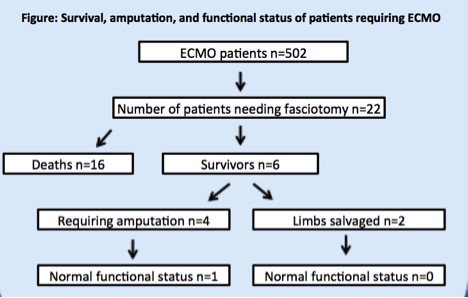Association Of Liver Function And Mortality In Patients With Compartment Hypertension Limb-threat Ischemia Undergoing Extracorporeal Circulatory Support
Joshua E. Robins, MD, Claire Motyl, BA, Peng Zhao, MD, Mark Balceniuk, MD, Brian Ayers, BS, MBA, Adam Doyle, MD, Roan Glocker, MD, MPH, Michael Stoner, MD.
University of Rochester, Rochester, NY, USA.
OBJECTIVES: The rate of Extracorporeal Membrane Oxygenation (ECMO) placement is increasing. The large cannulas needed for ECMO may result in significant peripheral vascular complications. The outcomes of lower extremity ischemia in the setting of ECMO are not well described in the literature, nor are predictors of survival. The purpose of our study was to evaluate survival, predictors of mortality, and limb salvage rate in patients undergoing lower extremity fasciotomy in the setting of ECMO.
METHODS: A single institution, retrospective review of a prospectively maintained database identifying all patients placed on ECMO at our institution from 2015 through 2018 was performed. All patients who underwent fasciotomy were evaluated. Primary endpoint was amputation free survival at time of discharge.
RESULTS: Five hundred and two patients were placed on ECMO from 2015 to 2018 (Figure). Twenty-two (4.4%) required fasciotomy for increased compartment pressures in the setting of limb ischemia. The mean age of patients receiving fasciotomy was 54.6 ± 14.9 years. Sixteen patients had reperfusion catheters in place at the time of diagnosis of compartment hypertension. No patients had reperfusion catheters placed after the time of diagnosis. Of the 22 who received fasciotomies, 16 patients died during hospitalization. Liver function, as measured by International Normalized Ratio (INR) was significantly worse in patients suffering mortality (2.04±0.20 versus 1.23± 0.06, p = 0.024). MELD (Model for End-Stage Live Disease) score was also worse in the mortality group (22.56 ±, 2.24 versus 16.33±, 2.65, p =0.048). Six patients survived to discharge. Four of the surviving 6 (66%) required major amputation. The only patient with no functional deficits at 6 months, received an above the knee amputation while hospitalized.
CONCLUSIONS: This is the first study to specifically evaluate the morbidity and mortality of ECMO patients who require fasciotomy. These data demonstrate that the majority of individuals requiring fasciotomy die during their hospitalization and of those who survive, most require amputation. Hepatic function is a strong predictor of mortality, and should weigh heavily in the decision algorithm for limb preservation. Overall amputation-free survival is less than 10% in this patient population, with those surviving having poor functional status. 
Back to 2020 Abstracts
